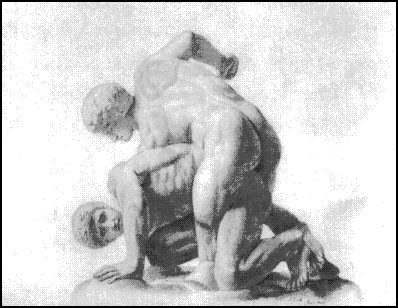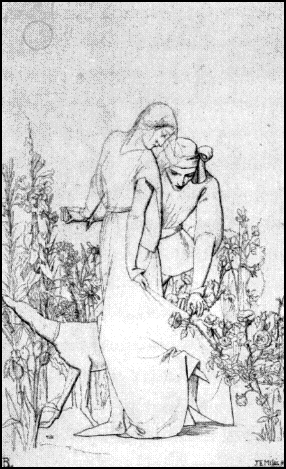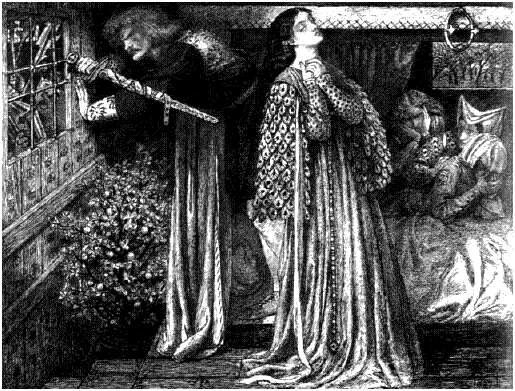Pre-Raphaelites
Elizabeth Prettejohn
(Princeton)
 They were a talented bunch --- John Everett Millais, William Morris, Dante Gabriel Rossetti, William Holman Hunt, Ford Madox Brown. One is almost tempted to call them illustrators. They were big on representations of characters out of literature --- Hamlet's Ophelia, Dante's Beatrice, Sir Launcelot, Tennyson's "Lady of Shalott," characters from the Bible (Esther, Jesus), angels, fairies, the Druids, and those wonderful long-nosed, long-faced sexy-sexless women so favored by Rossetti.
They were a talented bunch --- John Everett Millais, William Morris, Dante Gabriel Rossetti, William Holman Hunt, Ford Madox Brown. One is almost tempted to call them illustrators. They were big on representations of characters out of literature --- Hamlet's Ophelia, Dante's Beatrice, Sir Launcelot, Tennyson's "Lady of Shalott," characters from the Bible (Esther, Jesus), angels, fairies, the Druids, and those wonderful long-nosed, long-faced sexy-sexless women so favored by Rossetti.Suffering was definitely de rigueure, especially when it consisted of a vague, unlocalized pain. They were technocrats, and like technocrats, they investigated the new chemicals of the day to find new colors, colors that would be brighter and stronger. They wanted to give, as the editor suggests, "the greenest greens and the purplest purples," "maximum visibility." Heightened light and shadow were part of it, but even in the shadows, it wasn't a dark world --- "rather one deeper and richer in color."
They favored detail, detail, and more detail --- a "truth- Then there are the tell-tale figures. Tall figures, looking off, or down, pensively --- like Morris' "Guenevere," Rossetti's "Prosperine," Solomon's "Sappho," or Waterhouse's "Lady of Shalott" (we can practically hear her moving about in her dark tower, She left the web, she left the loom Ms. Prettejohn with her Pre-Raphaelite name is a worthy guide to all this, addressing the questions of history and technique and impact --- all that came out of the famous Tate exhibit of 1984, which, she says, was perhaps the most comprehensive that was and will be. The editor isn't interested in scandal, or in questions of politics or correctness --- but she is interested in origins and techniques. As all must concede, Millais, Morris, Rossetti, Hunt et al were masters of specificity --- eyes and shadows and reeds and clothing so exactly rendered that you are there, sometimes too much so. But under this all is a strange kind of wishy-washy stasis which is best represented not only by their icon, the vague Lady of Shalott, but as well by Rossetti's famous call of 1848, "To the Young Painters of England in memory of those before Raphael," Whew! "...shall give a Future to their Past..." As Pogo used to say, if you can figure that one out, you can have it. There are line drawings, close-ups, and 170 color reproductions, 300 pages in all. It's wonderful.
She made three paces thro' the room
She saw the water-lily bloom,
She saw the helmet and the plume,
She look'd down to Camelot.
Out flew the web and floated wide;
The mirror crack'd from side to side;
'The curse is come upon me,' cried
The Lady of Shalott. O aching love, longing for far-off places, the world of knights and courtly love, nature unspoil't by factories and cities, idealized pictures of work, of religious figures --- no dirt and stink and dust and blood. Late sun, long shadows, sunset --- impending darkness, but filled with such a light that one cannot but think that it is eternal.
O aching love, longing for far-off places, the world of knights and courtly love, nature unspoil't by factories and cities, idealized pictures of work, of religious figures --- no dirt and stink and dust and blood. Late sun, long shadows, sunset --- impending darkness, but filled with such a light that one cannot but think that it is eternal.
Called these to labour in His vineyard first,
Before the husk of darkness was well burst
Bidding them grope their way out and bestir,
(Who, questioned of their wages, answered, "Sir,
Unto each man a penny:") though the worst
Burthen of heat was theirs and the dry thirst;
Though God has since found none such as these were
To do their work like them: --- Because of this
Stand ye not idle in the market-place.
Which of ye knoweth he is not that last
Who may be first by faith and will? --- yea, his
The hand which after the appointed days
And hours shall give a Future to their Past?
